Dutch ESF design works well in Alberta
Posted in: Environment, Production by admin on July 14, 2011 | No Comments
A layout for group sow housing with electronic feeders that came from Holland has been working well for six years at Plain Lake Colony, Two Hills, Alberta. And, while there are a few things that he’d do differently with the benefit of experience, Hog Boss Ben Hofer says that he is very happy with the system and wouldn’t go back to sow stalls. In 2002, the Colony replaced its old 120-sow farrow to finish barn and constructed a new1200-sow unit producing isowean pigs. “We felt that sooner or later, we would be forced into using group housing, but we were also optimistic about its potential,” says Hofer, who is a Director of Alberta Pork. “We thought we could learn from the experiences in Europe and build a good system.” Having looked at both electronic feeding (ESF) and floor feeding, he felt that sow welfare was much better in the ESF system.
The decision was taken to use slatted floors rather than straw bedding, something the Dutch have a lot of experience with. All parts of the pen are slatted, apart from the lying areas. Overall pen size is 54ft x 25ft, providing a total of 24 square feet per sow and there are 6 separate lying areas divided by concrete walls, three each side of a slatted dunging area. The Nedap feeders, from Holland, are located at the front of the pen, adjacent to the access alleyway, so that they can easily be observed. “We chose the Nedap feeder because it had the fewest moving parts and the least amount of electronics on the feeder itself, which means less maintenance,” Hofer explains. “Also, some people advised us to have a feeder with a sensor on the back gate to avoid sows returning to the feeder soon after eating, but we don’t believe that’s necessary with the layout we have.” When sows leave the feeder after eating, they have to walk along a slatted alley, where the drinkers are located, and around the back of the pen, in order to return to the feeding area, which prevents constant re-visiting of the feeder by dominant sows. “This allows less dominant sows easier access to the feeder,” notes Hofer.
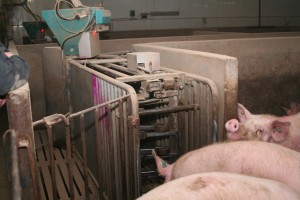 Each week about 60 sows are bred in order to achieve the farrowing target of 56 per week, with sows being transferred to the group pens within 7 days of breeding. These “fixed” groups, with sows that were all bred in the same week, are much easier to manage. A boar is taken into the pen to check for returns at 18-24 days and again three weeks later. Scanning takes place at 30 days and again at around 56 days. Sows that are not pregnant are removed and returned to the breeding area.
Each week about 60 sows are bred in order to achieve the farrowing target of 56 per week, with sows being transferred to the group pens within 7 days of breeding. These “fixed” groups, with sows that were all bred in the same week, are much easier to manage. A boar is taken into the pen to check for returns at 18-24 days and again three weeks later. Scanning takes place at 30 days and again at around 56 days. Sows that are not pregnant are removed and returned to the breeding area.
Prior to breeding, gilts are housed in two large training pens adjacent to the breeding area, which each have two electronic feeders. Gilts enter the unit in groups of 40 at a weight of 110-115kg and there are 80 gilts per pen. Any gilt that does not learn to feed quickly is placed in the feeder, but there have been very few problems with training, Ben Hofer notes. “Less than 1% of gilts have failed to use the feeder,” he explains. “Of the first 600 gilts, only one needed to be culled for this reason, so it’s hardly worth mentioning.” Vasectomized boars are used for stimulation and are used to breed gilts at least once prior to natural service at second or third heat. This practice has been shown to increase first litter size. After breeding, gilts are mixed in the weekly groups with sows, a practice that Hofer says he would prefer to avoid. “If we did this again, I would have three large groups so that gilts and parity 1 sows could be housed separately from older sows,” he says.
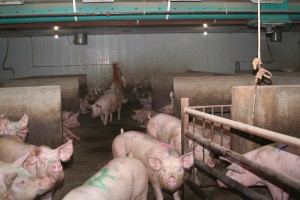 The benefits of individual feeding are apparent from the very even body condition of sows in the groups. Feed levels are regularly adjusted according to condition and the feeder ensures accurate feed delivery. Feed is dispensed in drops of 70 grams, every 20 seconds for sows and every 30 seconds for gilts, together with 50ml of water. The feeding cycle starts at 9.00pm, which means that, by morning, the majority of sows have fed, allowing the operator to identify any that have failed to feed. “The computer prints out an attention list and sometimes there will be 4-5 sows that have not eaten,” explains Hofer. “We don’t worry if they miss one day because most sows will eat the day after, but on day two we’ll check on the sows.” The most common reasons for feeding not taking place are lost electronic ear tags, sows that are lame and sows on heat, he says.
The benefits of individual feeding are apparent from the very even body condition of sows in the groups. Feed levels are regularly adjusted according to condition and the feeder ensures accurate feed delivery. Feed is dispensed in drops of 70 grams, every 20 seconds for sows and every 30 seconds for gilts, together with 50ml of water. The feeding cycle starts at 9.00pm, which means that, by morning, the majority of sows have fed, allowing the operator to identify any that have failed to feed. “The computer prints out an attention list and sometimes there will be 4-5 sows that have not eaten,” explains Hofer. “We don’t worry if they miss one day because most sows will eat the day after, but on day two we’ll check on the sows.” The most common reasons for feeding not taking place are lost electronic ear tags, sows that are lame and sows on heat, he says.
Experience with the system has been very positive and production runs at around 26 pigs weaned per sow, despite a roof collapse last year that put a bit of a dent in the figures. “It’s a nice environment to work in,” Hofer comments. “You can walk in and work with the sows whenever you want and they are very quiet.” He also notes that sows get more exercise than those in stalls, which means that they have better muscle condition, leading to fewer problems at farrowing. Observing and understanding sow behaviour is the key to successful management, Hofer says. “You have to handle the animals and listen to what they are telling you, not tell them what to do!” he exclaims.
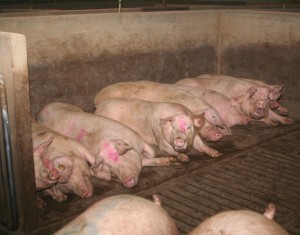 The only major aspect of the system that he would change is the type of slat. “We installed finishing slats and they are too narrow, which means we get some leg problems when sows fight after mixing,” he says. “I would prefer a slat that’s 5 to 6 inches wide, with a three-quarter inch gap to provide better support for the sow’s feet and to minimize injuries.” Another minor problem occurs when pens are part filled. “The sows tend to dung in any area that is not used for lying, which then needs cleaning out manually,” notes Hofer.
The only major aspect of the system that he would change is the type of slat. “We installed finishing slats and they are too narrow, which means we get some leg problems when sows fight after mixing,” he says. “I would prefer a slat that’s 5 to 6 inches wide, with a three-quarter inch gap to provide better support for the sow’s feet and to minimize injuries.” Another minor problem occurs when pens are part filled. “The sows tend to dung in any area that is not used for lying, which then needs cleaning out manually,” notes Hofer.
The need for maintenance and repair of electronic feeders is often cited as a problem, but experience at Plain Lake has been generally positive. “We had some initial problems with the electronic boards, but they were changed and have been working without a hitch for the last three years,” says Hofer. “The only other thing we occasionally have a problem with is the springs on the entry and exit gates, but they are easy to change.” The barn staff does the maintenance themselves, with guidance from the manufacturer by phone if required. “We’ve figured it out ourselves because most electricians and computer guys don’t understand it,” Hofer adds.
Overall, the verdict is that the system is a success and the design works well. Gilts and sows have adapted well to the feeders and production is good. Not only that but sows are calm and quiet to work with, spending most of their time asleep in the lying areas. “Learning to get used to the system was a bigger learning experience for the people than the pigs,” Hofer laughs.
Photo captions:
- Nedap feeder – The Nedap electronic feeder note the exit race that takes sows away from the feeding area once they have eaten
- Gilt pen – One of the two gilt pens showing the layout of the lying area with the slatted area in between
- Sows in lying area – Sows resting in the lying area
Controlling energy costs in the barn
Posted in: Environment, Production by admin on | No Comments
As we approach winter in tight financial times in the swine industry, producer’s thoughts are turning to how to best manage their heating and ventilation systems to keep their utility and energy expenses in line.
There are few publicly available production cost summaries. One of the best is the information from the Center for Farm Financial Management at the University of Minnesota (www.finbin.umn.edu). For the 4 year period of 2004-2007, wean-to-finish cooperators in this record program reported an average fuel and oil expense of $1.43 per pig and a utilities expense of $1.04 per pig. Fuel and oil includes both propane and any diesel and gasoline charged to the swine unit for such items as tractors, lawn mowers, power washers, generators, pickups, etc. Utilities include electricity and telephone/internet. Surprisingly, both fuel and oil and utilities varied little for the 4 year period. There was no indication in the data set of what the mix is of curtain sided versus tunnel wean-finish facilities.
Finishers of feeder pigs reported fuel and oil expenses of $0.71/pig and utility expenses of $0.62/pig. For farrow-weaning cooperators (average inventory of 950 sows), the fuel and oil expense was $0.49 per pig weaned while utilities were $1.03/pig weaned.
Once facilities are tightened for winter operation and have the appropriate insulation in the ceiling and side walls, the major causes of excessive heating expenses are:
- improper minimum ventilation rates
- improper furnace sizing
- improper temperature selection
As I work with a large number of different types of facilities and production systems in the upper Midwest and Canada, I continually find that producers have a very limited knowledge of their ventilation system. In most situations, they don’t have any idea of the capacity of their system, nor do they fully understand the impact of small ventilation mistakes on propane usage.
The MWPS (Midwest Plan Service) recommends the following minimum ventilation rates for moisture control in swine facilities:
Weaning – 30 lb (13.6 kg) 2 cfm/pig
30-75 lb (13.6- 34 kg) 3 cfm/pig
75-150 lb (34-68 kg) 7 cfm/pig
>150 lb (> 68 kg) 10 cfm/pig
Gestating female 12 cfm/female
Farrowing 20 cfm/crate
These numbers don’t mean much to most producers until you add in the approximate capacity of various sized fans. While such items as shutters, discharge cones, hoods, etc have an impact on the capacity of exhaust fans in negative pressure systems, the following rough estimates are valuable starting points for producers trying to understand their ventilation systems:
Fan blade diameter, in. Approximate CFM
12 1200
14 2000
16 2500
20 4500
24 6000
36 12000
Suppose that you have a 300 head weaned pig room, and there is a 12” fan running as the minimum fan. This fan has the capacity for 4 cfm per pig, which is twice the recommended minimum ventilation rate. Either this fan needs to be replaced with a smaller fan, or it needs to be connected to a variable speed controller and set to operate at 50% of its rated output. Notice that I didn’t say 50% of its rated speed or 50% on the controller. Generally small variable speed fans achieve 50% of their rated output at approximately 65-70% of their rated rpms. Twenty four (24) in. diameter fans often achieve 50% of their rated output at 60-65% of their maximum rpms.
There is quite a bit of variation between ventilation controllers on how they control variable speed fans. Depending on the controller specifics, a 50% setting as the minimum speed may or may not be anywhere close to the intended 50% operating performance.
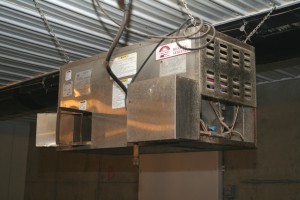 Improper furnace sizing is usually the result of installation of a furnace that is too large for the facility. A furnace is large enough if is shuts off occasionally on the coldest day of the year. When furnaces are too large, the end result is rooms that have large temperature variations when the furnace operates. Many times this results in the temperature at the controller temperature probe rising beyond the room set point, resulting in the ventilation system increasing the ventilation rate to remove the extra heat, which means the room cools and the process starts again.
Improper furnace sizing is usually the result of installation of a furnace that is too large for the facility. A furnace is large enough if is shuts off occasionally on the coldest day of the year. When furnaces are too large, the end result is rooms that have large temperature variations when the furnace operates. Many times this results in the temperature at the controller temperature probe rising beyond the room set point, resulting in the ventilation system increasing the ventilation rate to remove the extra heat, which means the room cools and the process starts again.
Most ventilation controllers log the high and low temperature for the last day or since the controller was last reset. Using the controller’s temperature logs, the high, low and set point temperatures should recorded on a daily basis. When the facility is operating in the heating mode, the daily high temperature should never be at or above the set point temperature. If the high gets to or above the set point, this suggests that the ventilation system responded by exhausting the heat just added to the room with the furnace. To prevent this from happening, as a starting point, set the furnace to shut off at 2oF (1oC) below the room set point temperature.
Many producers make the mistake of assuming that the set point temperature for the controller will be the room temperature at the temperature probe. This is not the case. In cold weather, if the furnace is set to turn off 2oF below the set point, the room temperature should be 2oF colder than set point as the furnace ‘OFF’ temperature is the control point for the room.
As pigs grow and produce increasing amounts of heat, the ventilation system responds by increasing the ventilation rate. If stage 1 is variable speed and has a 2oF bandwidth, when stage 1 is operating at 100% speed, the room must be 2oF warmer than set point. This is because the controller is set to not attain 100% speed unless the room is 2oF warmer. Set point is just the decision point from which the controller makes decisions as to which devices to operate in the ventilation and heating system.
Photo caption: Nursery heater-1 – Having more furnace or heater capacity than required leads to more variable temperatures and higher energy bills
Pigs learn what a mirror image represents and use it to obtain information
Posted in: Environment, Production, Welfare by admin on | No Comments
Mirror usage has been taken to indicate some degree of awareness in animals. Can pigs, obtain information from a mirror? When put in a pen with a mirror in it, young pigs made movements while apparently looking at their image. After 5 h spent with a mirror, the pigs were shown a familiar food bowl, visible in the mirror but hidden behind a solid barrier. Seven out of eight pigs found the food bowl in a mean of 23 s by going away from the mirror and around the barrier. Naïve pigs shown the same looked behind the mirror. The pigs were not locating the food bowl by odour, did not have a preference for the area where the food bowl was and did not go to that area when the food bowl was visible elsewhere. To use information from a mirror and find a food bowl, each pig must have observed features of its surroundings, remembered these and its own actions, deduced relationships among observed and remembered features and acted accordingly. This ability indicates assessment awareness in pigs. The results may have some effects on the design of housing conditions for pigs and may lead to better pig welfare.
Pigs learn what a mirror image represents and use it to obtain information
Understanding the response of your ventilation controller to changing conditions
Posted in: Environment, Production by admin on | No Comments
In both new and remodeled swine production facilities, it is not uncommon to have fans, inlets, heaters and controllers supplied by up to four different companies. While the ventilation controller is the hub for all heating and ventilation system operations, many, if not most, producers rely on their many suppliers and/or builders to integrate the components into a working system.
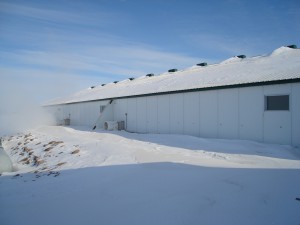 When construction and/or equipment installation is completed, there is often only a 20-30 minute ‘training’ session on the system and the producers are left to fend for themselves in management of the system. With four or more brands of equipment, there is most likely no detailed explanation of how and/or why the various components were chosen, nor is there detail as to the capacities of the components or verification of the settings most likely input into the ventilation controller by the installer.
When construction and/or equipment installation is completed, there is often only a 20-30 minute ‘training’ session on the system and the producers are left to fend for themselves in management of the system. With four or more brands of equipment, there is most likely no detailed explanation of how and/or why the various components were chosen, nor is there detail as to the capacities of the components or verification of the settings most likely input into the ventilation controller by the installer.
For many producers and their employees, ventilation controllers are something to be feared, meaning that operation of the entire heating and ventilation system remains a mystery.
The obvious place to start in understanding your ventilation system is to list the fans, furnaces and inlets installed, and the capacities of these devices. It is not enough to list the fans as ‘24 inch Multifan pit fans’ since that tells potential users of the information nothing about the capacity of the device or specific model number, an important criteria when ordering parts or estimating performance. For example, Multifan has 6 different 24” fans listed in the BESS Labs manual (www.bess.uiuc.edu) with capacities at 0.05 in. w.g. static pressure (1.25 mm w.g.) ranging from 4,520 to 7,280 cfm (7,680 to 12,370 m3/hr). Armed with fan specific information, it is possible to predict how a ventilation system will respond to various pig size during varying seasons and to compare the installed capacity versus recognized ventilation needs (Table 1).
Table 1: Recommended minimum (cold weather) ventilation rates for moisture control in growing pig facilities. MWPS (1990)
| Pig Wt, kg | CFM | m3/hr |
| 5-13 | 2 | 3.4 |
| 13-34 | 3 | 5.1 |
| 34-68 | 7 | 11.9 |
| 68+ | 10 | 17.0 |
Assuming insulation values of R=35 for ceilings and R=20 for side walls, combining pig heat production estimates (Brown-Brandl et al, 2004) with facility heat loss equations (MWPS, 1977) make it possible to create Table 2. The balance point temperature in Table 2 is the estimated incoming air temperature at which heat production equals heat loss via the ventilation system and insulated walls at various combinations of pig weight and room temperatures. Note that the cfm’s chosen represent typical fan ventilation capacities for fully slatted wean-finish and grow-finish facilities in the US. For example, the 10 cfm rate would represent 2 -24 in. diameter pit fans at 100% of rated capacity in a 1200 head room, while the 5 cfm would be the fans operating as variable speed fans at 50% of capacity, etc.
Table 2: Balance point temperature (in C degree) for growing pig facilities
| Set Point | CFM/pig | |||||||
| Pig Wt | Temperature | 2.5 | 5 | 10 | 15 | 20 | ||
| Kg | oC | oC Balance Point Temperature | ||||||
| 11 | 26 | -17 | 4 | 16 | 20 | 23 | ||
| 23 | 22 | -42 | -11 | 6 | 13 | 16 | ||
| 45 | 18 | -33 | -7 | 3 | 8 | |||
| 68 | 17 | -49 | -15 | -4 | 3 | |||
| 91 | 17 | -62 | -22 | -8 | 0 | |||
For pigs weighing 23 kg, if the set point of the controller is 22o C, and the first stage variable speed fan has a bandwidth of 1.1o C (2o F) with the minimum speed set to ventilate at 5 cfm/pig, the room is in balance when the incoming air (outside air temperature) is -11o C. That is, if the incoming air temperature is lower than this, heat must be added to the room or facility, or the room temperature will gradually lower. If the incoming air temperature is higher than this, the ventilation system will gradually increase the amount of air removed (increased cfm), while also raising room temperature. When the stage 1 fan(s) is running at 100% speed (often 10 cfm/pig in US fully slatted finishing facilities), the room temperature is 1.1o C higher (bandwidth setting in the controller) than the set point and the incoming air will now be approximately 6o C.
In essence, Table 2 allows producers to develop an expectation of how their ventilation system should operate. When they walk into a room or facility, with pigs of a certain size, given outside air temperature, which fan(s) should be operating, and for variable speed fans, what speed should they be operating at? For example, with 45 kg BW pigs, if the outside air temperature is near 0o C, the first stage fans (10 cfm) should be operating at full speed, and the second stage fans (an additional 10 cfm in US facilities) should be cycling on and off. For 91 kg BW pigs, the same outside conditions should mean that stage 1 and stage 2 fans are at or very near to full speed (20 cfm in a typical US facility).
As Table 2 illustrates, one of the biggest ventilation challenges in many production facilities is to get the ventilation rate low enough for 11 kg or smaller pigs. In well insulated facilities, the balance point changes from -17o C to 4o C as the ventilation rate increases from 2.5 to 5 cfm/pig for 11 kg pigs. At the 5 cmf/pig rate this means that heat must be added to the system, either as room heat or supplemental zone heat whenever the incoming air is colder than 4o C.
References
Brown-Brandl, T.M., J.A. Nienaber, H. Xin and R.S. Gates. 2004. A literature review of swine heat production. Trans. ASAE 47(1):259-270.
MWPS. 1997. Structures and Environment Handbook. MWPS-1. Midwest Plan Service, Iowa State University, Ames.
MWPS. 1990. Mechanical Ventilating Systems. MWPS-32. Midwest Plan Service, Iowa State University, Ames.
Photo Caption: Hog barn-1
Remodelling expands Big Sky sow base
Posted in: Environment, Production, Uncategorized, Welfare by admin on | No Comments
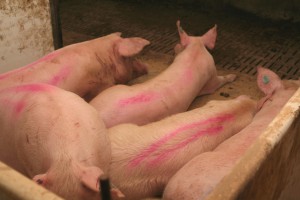 Complete remodelling of 600-sow farrow to finish barns into 1800-sow units producing isowean pigs is the route to expanding the sow base at Humboldt, Sask. based Big Sky Farms, which currently has 49,000 sows. And, says production manager Richard Johnson, it will cut overhead costs per sow leading to a lower cost per piglet produced. The company purchased the assets of Community Pork Ventures (CPV) in 2005, a production system that had been based on 600-sow farrow to finish barns, with four units in the 12,000 sow operation holding 1200 sows. However, the Big Sky production model was based on three-site production, with large-scale breeding units, off-site nurseries and contract finishing barns. “As we got to know and work with the CPV system, we thought there was an opportunity to expand and/or retrofit the systems, which in turn would give us a greater return on capital invested,” explains Johnson. “Not only can we spread our central overhead and management costs over more sows but the specialization in just breeding and farrowing leads to better results.”
Complete remodelling of 600-sow farrow to finish barns into 1800-sow units producing isowean pigs is the route to expanding the sow base at Humboldt, Sask. based Big Sky Farms, which currently has 49,000 sows. And, says production manager Richard Johnson, it will cut overhead costs per sow leading to a lower cost per piglet produced. The company purchased the assets of Community Pork Ventures (CPV) in 2005, a production system that had been based on 600-sow farrow to finish barns, with four units in the 12,000 sow operation holding 1200 sows. However, the Big Sky production model was based on three-site production, with large-scale breeding units, off-site nurseries and contract finishing barns. “As we got to know and work with the CPV system, we thought there was an opportunity to expand and/or retrofit the systems, which in turn would give us a greater return on capital invested,” explains Johnson. “Not only can we spread our central overhead and management costs over more sows but the specialization in just breeding and farrowing leads to better results.”
The first unit to undergo the transformation was the company’s Kelsey barn, located near Melfort, Sask. Additional sow pens were made by modifying the existing part slatted finishing rooms, which had pens of 23 pigs. Three pens were made into one, although the pen divisions between the lying areas were left in place. Each pen now holds 30 sows, which are fed on the floor using volumetric drop dispensers. One of the finisher rooms was left with 12 small pens in order to house sick, lame or thin sows, something Johnson knew was essential in a floor-fed system from his previous experience with group housing in the UK. In addition, two of the grower rooms were also converted to sows pens, giving a total capacity for 1120 sows from 30 days into gestation up to removal for farrowing. The remaining 6 grower rooms were used to construct a further 240 farrowing pens, while the original nursery rooms hold piglets ready for shipping. From weaning until 30 days, sows are housed in stalls in the existing breeding and gestation areas.
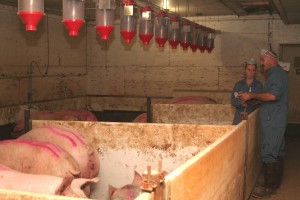 Experience with the group sow pens has been generally positive, but not without its teething problems, says unit manager Susan Armstrong. “Our biggest problem has been variation in the weight of feed dispensed, which has ranged from 7-12 lb per drop, making it difficult to feed accurately.” Gilts are penned separately and sows are grouped by body condition in order to feed more accurately, something that’s necessary when floor feeding. However, that makes it more difficult to remove sows for farrowing, says Armstrong. “We can’t remove all the sows at one time as we would if they were grouped strictly by breeding date,” she explains. Also, sow behaviour is rather aggressive with floor feeding, although no vulva biting has been noted so far. Scanning sows in the group has proved more difficult than when sows are in stalls. “We carry out the first scan when sows are in stalls in the implantation area, but we also like to do a second confirmation of pregnancy at 65 days,” Armstrong says.
Experience with the group sow pens has been generally positive, but not without its teething problems, says unit manager Susan Armstrong. “Our biggest problem has been variation in the weight of feed dispensed, which has ranged from 7-12 lb per drop, making it difficult to feed accurately.” Gilts are penned separately and sows are grouped by body condition in order to feed more accurately, something that’s necessary when floor feeding. However, that makes it more difficult to remove sows for farrowing, says Armstrong. “We can’t remove all the sows at one time as we would if they were grouped strictly by breeding date,” she explains. Also, sow behaviour is rather aggressive with floor feeding, although no vulva biting has been noted so far. Scanning sows in the group has proved more difficult than when sows are in stalls. “We carry out the first scan when sows are in stalls in the implantation area, but we also like to do a second confirmation of pregnancy at 65 days,” Armstrong says.
Farrowing the target of 85 sows per week started at the beginning of December and the goal is to wean 900 pigs per week at an age of 20-21 days. These are shipped to the USA with another 900 pigs from another barn to make up a full load of 1800. Big Sky has a contract in place for these pigs to be raised in wean-to-finish barns in Iowa, managed by South Central Management Services, but they retain ownership. Finished pigs will be marketed in the US Mid-West but, initially at least, not tied to a specific packer.
While the decision at the time was to finish pigs in the USA, they could just as easily be reared in low-cost contract finishing barns in Saskatchewan, says Richard Johnson. “It’s currently a lot more attractive to finish in the US, but that could change.” The main motivation for the unit remodelling was to improve return on capital, he stresses. “We will make more money doing this than operating a farrow to finish operation. We modelled a range of different scenarios for these barns with a range of feed prices and in every case the farrow to isowean option was the most profitable.”
Big Sky plans to convert more of the ex-CPV units, drawing on the experience of this first one, especially how the group housing works. “It may prove best to remove the partial pen divisions in the group pens, to allow for sows to move around freely while feeding.” Johnson feels. “Also, we may need to fine-tune space allowances and how we group sows according to age and condition.” So far, though, performance has been up to expectations, with the mainly gilt herd farrowing 11.9 born alive per litter.
In time, converting all the ten 600-sow barns would allow an increase in the company’s sow base of 12,000, but Johnson says that’s a long-term goal. “We do want to expand in order to reduce cost,” he says. “Also, having a lot of sows in group housing will give us additional marketing opportunities and could allow us to develop added value pork products.”
Photo captions:
- New_Sow_pens-1.jpg: Richard Johnson discusses the group sow pens with unit manager Susan Armstrong
2. Sows in group pens-1.jpg: Sows lie quietly in the converted finishing pens
Pigs Down Under
Posted in: Economics, Environment, Production, Uncategorized, Welfare by admin on | No Comments
High feed prices and low hog prices have led to a huge increase in sow slaughterings in Australia and there is a low level of confidence among producers, says production consultant John Riley. Meanwhile, imports of pork products soar, including those from Canada, putting even more pressure on producers.
The winter edition of the Western Hog Farmer summarizes the Canadian industry’s response to high feed costs, the weakness of the US dollar and unsatisfactory market returns.
The dismal picture in Canada is mirrored in the Australian industry. In the last month, one of the largest production units in Queensland that is owned by a Japanese company has been put on the market. If this 7,000 sow, farrow to finish business closes, there will be serious repercussions for the local feed mill and the two abattoirs in the state.
Another company to call it a day is the breeding company Hyfarm-JSR. They have sold their 600-sow high health nucleus unit to a Dutch family who recently settled in the state. In addition, the Hyfarm-JSR multiplication unit is now on the market with limited expressions of interest by prospective purchasers.
Ironically, the Dutch family were encouraged to settle in Australia by a state government in 2002 which promoted the financial benefits of investing in the pig industry in Queensland.
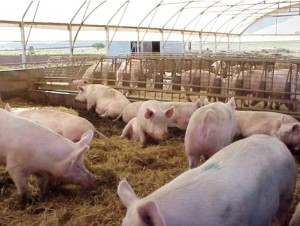 The Productivity Commission report that handed down its findings in December, determined that the unprofitability of the Australian industry was not due to imports from the USA, Denmark and Canada, but was due to high feed costs.
The Productivity Commission report that handed down its findings in December, determined that the unprofitability of the Australian industry was not due to imports from the USA, Denmark and Canada, but was due to high feed costs.
In parts of New South Wales and Queensland, harvesting of the sorghum crop is well advanced with record yields being recorded. Sorghum is a summer grain crop used in animal feeds. Normally the price is around $AU160 per tonne but this year the price is holding firm at around $AU$260 per tonne due to the high demand worldwide for wheat and barley. The usual seasonal reduction in average feed costs has not materialized so far in 2008.
During the last quarter of 2007, sow slaughtering was 49.5% higher than in the last quarter of 2006. The level of imports of processed pig meat during the 12 months ending December 2007 was 29% higher than in 2006 with imports from Canada totalling 43,415 tonnes shipped weight, an increase of 24.8% on the previous year. In the same period imports from the United States increased by 52%.
The lack of confidence in the industry has resulted in very little investment in housing systems that comply with the new welfare codes. The codes dictate that within ten years, housing of sows in stalls for more than four weeks during gestation will not be allowed.
A few producers in the east that have moved to group housing in gestation have adapted grower pens and introduced feeding of small groups.
In some instances in Western Australia sows have been housed in larger groups on deep litter in shelters and fed through traditional feeding stalls on a concrete pad in or adjacent to the shelter. The feeding stalls service more than one group of pigs on a rotation system. The main disadvantage of the system is the high labour required in moving sows.
There is only limited interest in electronic feeding systems. In the past Australia’s isolation in regard to after sales services has led to frustration and a few systems that were installed in the early 1990’s were subsequently removed. However, interest has been rekindled in recent months and two large-scale producers have installed Mannebeck systems in naturally ventilated slatted floor sheds.
In addition to high feed costs and poor market returns, producers in Queensland were shocked to read in March of their state government’s proposal to increase the cost of meeting the environmental legislation. The proposal, if implemented, will see a producer with 100 sows producing bacon pigs paying $52 per sow per year to government and a producer with 600 sows with progeny to bacon will pay about $9,800 per annum. The State government has decided on a policy of full cost recovery from potential polluters of the environment for the implementation and the policing of the legislation. Interestingly a local mining company selling gold worth $108 million will pay just $20,000 if the legislation is passed.
A further major change will dictate that multi-site operations will pay the fee on every site because multi site discounts will be withdrawn. Pig producers in Queensland are far from happy and more could well exit the industry in the next six months.
Photo caption:
Group sows-1 – Producers in Australia are moving towards group sow housing
News and Views – Expedited LMO process will speed up foreign worker recruitment
Posted in: Economics, Environment by admin on | No Comments
Alberta Pork, in conjunction with Alberta Agriculture and Food and Service Canada, has established an Expedited LMO Program that will drastically speed up the process of obtaining a Labour Market Opinion. Obtaining an LMO document is the first stage in the process of employing a worker from overseas.
The Alberta Pork website is currently being updated in order to provide producers with all the information they need to understand the processes involved in recruiting and employing a foreign worker, including how to complete the LMO application form.
The process involves Alberta Pork receiving completed LMO applications from producers and checking them to ensure they are correct prior to forwarding them to Service Canada. In this way, it will provide a means of “quality control” so that all applications are of the required standard, allowing them to be processed quickly. Producers are, of course, free to make an application directly to Service Canada, who will deal with it in the normal manner, points out Alberta Pork.
In order to assist producers further, a database of foreign workers who have been interviewed in their country is being established in order to provide a pool of suitable candidates, initially from the Philippines, Mexico and Europe. Producers will be offered a shortlist of candidates depending on the job position and the skills and experience required.
Bernie Peet, of Pork Chain Consulting Ltd., has been contracted to assist with this project and will be carrying out the day-to-day work on behalf of Alberta Pork. Alberta Agriculture and Food has provided funding for the project. For further information, please contact Stuart McKie of Alberta Pork – Phone: (780) 491-3527 Cell: (780) 307-5853, or Bernie Peet, Pork Chain Consulting Ltd. – Phone: (403) 782-3776 Cell: (403) 392-3104
News and Views – End of KVD to benefit livestock producers
Posted in: Environment, Production by admin on | No Comments
Minister of Agriculture Gerry Ritz announced on February 11th the full removal of kernel visual distinguishability (KVD) as a variety registration screening criterion for all classes of Western Canadian wheat as of August 1, 2008. “Canadian farmers need access to the best crop science and varieties to be successful and the Government of Canada is working to give producers every advantage,” said Minister Ritz. “Moving beyond KVD will allow Canadian farmers to harness the potential of new crop varieties tailored to livestock nutrition and biofuel production.”
The Canadian Grain Commission (CGC) announced in June 2006 that KVD would end for the minor classes of wheat by August 1, 2008. The recent announcement extends the
removal of KVD in 2008 to all classes of Western Canadian wheat, including Canada
Western Red Spring and Canada Western Amber Durum.
Removing the KVD requirements for wheat registration and segregation will allow for the development and registration of new high-yielding varieties of wheat suitable for other uses such as feed and biofuels, without requiring that they look different than milling wheats.
“Think Plastics” for barn applications
Posted in: Environment by admin on | No Comments
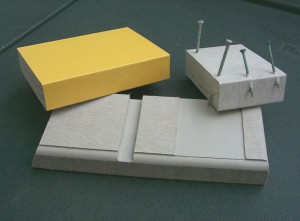 Two innovative environmental products, ideal for pig barns and other farm applications, are now available in western Canada.
Two innovative environmental products, ideal for pig barns and other farm applications, are now available in western Canada.
Think Plastics Inc. of New Hamburg, Ontario manufactures Baleboard®, a 100% solid polyethylene plastic lumber made from recycled agricultural bale wrap and greenhouse film. Since 2005, the company has diverted more than 636-tonnes of scrap plastic from landfill sites and burn barrels in south central Ontario.
Baleboard® can be used in any non-load bearing application where wood and composite products are used. It contains no wood or other fillers. Company President Chuck Sparks says that’s the reason the product is so popular. “Baleboard® is one polymer – polyethylene – which makes it extremely strong and versatile. It is a popular choice for home decks and cottage docks. But its resistance to ammonia, oil and gas, and the fact that the boards are not slippery when wet, also make it an excellent choice for use on the farm.” Baleboard® can be power-washed and steam-cleaned. Lab tests show it does not rot or leach. Sparks adds, “We haven’t found an animal yet that can chew it.”
Baleboard® is available in two colours, Sandstone and Cedartone, and five sizes: square-edged 2” x 4” x 12’, 2” x 6” x 12’, 4” x 4” x 10’, and round-edged Custom 2” x 6” x 12’ and 5/4” x 6” x 12’. The Ontario company also manufactures “Nusheet”, a flexible 4’ x 8’ off-white sheet, 1/8” thick, made from recycled greenhouse film. Nusheet is being used to line barn walls, horse wash stalls, shelves, trucks interiors and sheds.
Baleboard® and Nusheet are available in the west through Riverbend Building Supplies. Contact Michael Maendel at (204) 761-0252, email Michael@rb.hbni.net, or visit www.riverbendbuilding.com
Photo Caption:
(Baleboard) Baleboard can be routed and planed – even painted. It can be nailed and screwed close to the edge without splitting or breaking.
Portable sorter designed for small group systems
Posted in: Environment, Production, Uncategorized by admin on | No Comments
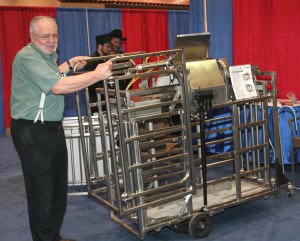 Automatic sorting systems for finishing pigs are becoming more and more common. However, they are only justified economically where group size is 500 or more. In order to gain the same benefits where pigs are housed in smaller groups, Crystal Spring Hog Equipment, based in St. Agathe, Man., have developed the “egate” portable electronic sorter. Constructed in stainless steel, its unique feature is that the rear end of the weighing crate folds up, reducing the length of the scale, which allows it to be moved around in conventional barn layouts with a central alleyway. Jonathan Kleinsasser, Managing Director of Crystal Spring, says that the scale marks pigs automatically if they are ready for market and also marks pigs that will be ready the following week. It displays the average weight of these two groups of pigs and the average weight of all the pigs weighed, so that growth rate can be calculated. The crate has an automatic sorting gate, which allows selection and removal of market weight hogs, while the others can be returned to the pen.
Automatic sorting systems for finishing pigs are becoming more and more common. However, they are only justified economically where group size is 500 or more. In order to gain the same benefits where pigs are housed in smaller groups, Crystal Spring Hog Equipment, based in St. Agathe, Man., have developed the “egate” portable electronic sorter. Constructed in stainless steel, its unique feature is that the rear end of the weighing crate folds up, reducing the length of the scale, which allows it to be moved around in conventional barn layouts with a central alleyway. Jonathan Kleinsasser, Managing Director of Crystal Spring, says that the scale marks pigs automatically if they are ready for market and also marks pigs that will be ready the following week. It displays the average weight of these two groups of pigs and the average weight of all the pigs weighed, so that growth rate can be calculated. The crate has an automatic sorting gate, which allows selection and removal of market weight hogs, while the others can be returned to the pen.
For further information, contact Jonathan Kleinsasser on (204) 433-7178, email info@crystalspringhog.com or visit www.crystalspringhog.com
Photo:
Portable sorter – The egate portable sorter has a fold-up rear section making it easier to move around









